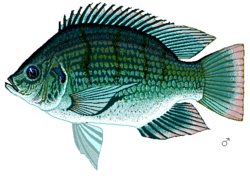| Mango tilapia | |
|---|---|
 | |
| Scientific classification | |
| Kingdom: | Animalia |
| Phylum: | Chordata |
| Class: | Actinopterygii |
| Order: | Cichliformes |
| Family: | Cichlidae |
| Genus: | Sarotherodon |
| Species: | S. galilaeus |
| Binomial name | |
| Sarotherodon galilaeus | |
| Synonyms | |
| |
The mango tilapia (Sarotherodon galilaeus) is a species of fish from the cichlid family that is native to fresh and brackish waters in Africa and the Levant. [2] Other common names include Galilaea tilapia, Galilean comb, Galilee St. Peter's fish, and St. Peter's fish. [3] (To differentiate from other Israeli species of "St. Peter's fish" see below.) This is a relatively large cichlid at up to 41 centimetres (16 in) in total length and about 1.6 kilograms (3.5 lb) in weight. [2] It is very important to local fisheries and the species is also aquacultured. [1]
Contents
In addition to the nominate subspecies, four subspecies are recognised. [2] These are:
- Sarotherodon galilaeus borkuanus
 in Chad [4]
in Chad [4] - Sarotherodon galilaeus boulengeri
- Sarotherodon galilaeus multifasciatus
 in Burkina Faso, Côte d'Ivoire and Ghana [5]
in Burkina Faso, Côte d'Ivoire and Ghana [5] - Sarotherodon galilaeus sanagaensis
It is a mouthbrooder. The mating strategies can vary. Both uni-parent and bi-parent mouthbrooding is used, and monogamous or polygamous behaviour. [6]
